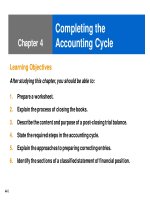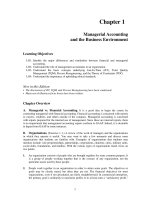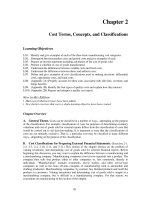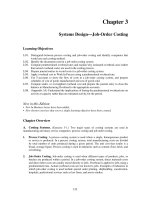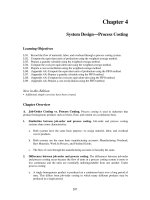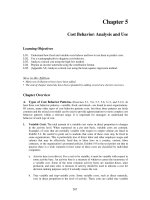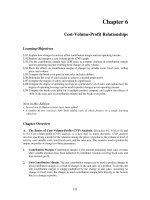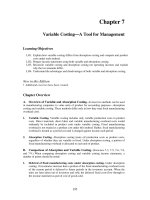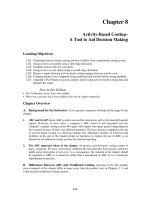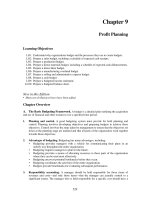Overview managerial accounting chapter 04
Bạn đang xem bản rút gọn của tài liệu. Xem và tải ngay bản đầy đủ của tài liệu tại đây (2.65 MB, 61 trang )
Chapter 4
System Design—Process Costing
Learning Objectives
LO1.
LO2.
LO3.
LO4.
LO5.
LO6.
LO7.
LO8.
LO9.
Record the flow of materials, labor, and overhead through a process costing system.
Compute the equivalent units of production using the weighted-average method.
Prepare a quantity schedule using the weighted-average method.
Compute the costs per equivalent unit using the weighted-average method.
Prepare a cost reconciliation using the weighted-average method.
(Appendix 4A) Compute the equivalent units of production using the FIFO method.
(Appendix 4A) Prepare a quantity schedule using the FIFO method.
(Appendix 4A) Compute the costs per equivalent unit using the FIFO method.
(Appendix 4A) Prepare a cost reconciliation using the FIFO method.
New in this Edition
• Additional simple exercises have been created.
Chapter Overview
A. Job-Order Costing vs. Process Costing. Process costing is used in industries that
produce homogenous products such as bricks, flour, and cement on a continuous basis.
1.
Similarities between job-order and process costing. Job-order and process costing
systems share some characteristics:
a. Both systems have the same basic purpose—to assign material, labor, and overhead
cost to products.
b. Both systems use the same basic manufacturing accounts: Manufacturing Overhead,
Raw Materials, Work In Process, and Finished Goods.
c. The flow of costs through the manufacturing accounts is basically the same.
2.
Differences between job-order and process costing. The differences between job-order
and process costing occur because the flow of units in a process costing system is more or
less continuous and the units are essentially indistinguishable from one another. Under
process costing:
a. A single homogenous product is produced on a continuous basis over a long period of
time. This differs from job-order costing in which many different products may be
produced in a single period.
207
b. Costs in process costing are accumulated by department, rather than by individual job.
c. The department production report is the key document in process costing, showing the
accumulation and disposition of cost. In job-order costing, the job-cost sheet is the key
document.
B. Overview of Process Costing. (Exercises 4-1 and 4-10.) Manufacturing costs are
accumulated in processing departments in a process costing system. A processing department is
any location in the organization where work is performed on a product and where materials,
labor, and overhead costs are added to the product. Processing departments should also have two
other features. First, the activity performed in the processing department should be essentially
the same for all units that pass through the department. Second, the output of the department
should be homogeneous. In process costing, the average cost of processing units for a period is
assigned to each unit passing through the department.
Two process costing methods are illustrated in the text—the weighted-average method and
the FIFO method. While the FIFO method provides more current cost data for decision-making
and performance evaluation purposes, it is more difficult for students to grasp. For that reason,
the FIFO method is covered in an appendix.
C. Equivalent Units of Product. (Exercises 4-2, 4-11, 4-13, and 4-17.) In order to
calculate the average cost per unit, the total number of units must be determined. Partially
completed units pose a difficulty that is overcome using the concept of equivalent units.
Equivalent units are the equivalent, in terms of completed units, of partially completed units.
The formula for computing equivalent units is:
Number of
Equivalent = partially completed × Percentage
units
completion
units
Equivalent units are the number of complete, whole units one could obtain from the materials
and effort contained in partially completed units.
Under the weighted-average method, the equivalent units for a particular cost category (e.g.,
materials or conversion cost) is computed by adding together the number of units completed and
transferred out to the next department during the period and the equivalent units in the ending
work in process inventory in the department.
Equivalent Units transferred to
Equivalent units
units of = the next department + in ending work in
production or to finished goods process inventory
D. Production Report. The purpose of a production report is to summarize all of the
activity that takes place in a department's work in process account for a period. A production
report consists of three parts:
• A quantity schedule and a computation of equivalent units.
• A computation of costs per equivalent unit.
• A reconciliation of all cost flows into and out of the department during the period.
208
E. Production Report: Weighted-Average Method. (Exercise 4-13 followed by
Exercise 4-14.) Emphasize that the weighted-average method does not attempt to separate units
in the beginning inventory from units started during the current period. Costs and units from
beginning inventory are blended together with costs and units from the current period.
1.
Quantity Schedule and Equivalent Units. (Exercises 4-2, 4-4, and 4-11.) The first step in
preparing a production report is to prepare a quantity schedule, which shows the physical
flow of units through the department. This schedule allows managers to see at glance how
many units moved through the department during the period. Using the quantity schedule,
the equivalent units can be easily computed.
2.
Costs per Equivalent Unit. (Exercises 4-6 and 4-13.) The second step in preparing a
production report is to calculate the costs per equivalent unit. The cost per equivalent unit is
computed for a particular cost category (i.e., materials, labor, overhead, or conversion) by
dividing its total cost by its total equivalent units. Note that under the weighted-average
method the costs include both the costs already in beginning inventory as well as the costs
added by the department during the current period.
3.
Cost Reconciliation. (Exercise 4-7.) The third step in preparing a production report is to
prepare a cost reconciliation. The purpose of a cost reconciliation is to show how the costs
from beginning work in process inventory and costs that have been added during the period
are accounted for.
a. Costs come into the department from units in beginning inventory, from material,
labor, and overhead costs that are added during the period, and from any units that
might have been transferred in from a prior department.
b. A department's costs are accounted for by showing the costs that are transferred out to
the next department (or to finished goods) and by specifying the costs that remain in
the ending work in process inventory.
F.
Operation Costing. The costing systems discussed in Chapters 3 and 4 represent the two
ends of a continuum. On one end is job-order costing and on the other is process costing.
Between the two extremes, there are many “hybrid” systems. Operation costing is an example of
such a hybrid system. It is used in situations where products have some common as well as
individual characteristics. TVs, for example, have some common characteristics in that all
models must be assembled and tested following the same basic steps. However, each model has
different components with different costs. The costs of the components (materials) would be
charged to a batch of a particular model individually, as in job-order costing, but the conversion
costs may be assigned using process costing.
G. FIFO Method (Appendix 4A). (Exercise 4-15 followed by Exercise 4-16.) The FIFO
method segregates the units and costs in the beginning inventory from the units and costs of the
current period.
1.
Quantity Schedule. (Exercises 4-5 and 4-12.) The quantity schedule prepared under the
FIFO method is identical to that prepared under the weighted-average method, except that
the “units transferred out” are separated into those units that came from beginning
inventory and those units that were started and completed this period.
209
2.
Equivalent Units. (Exercises 4-3 and 4-12.) The FIFO method differs from the weightedaverage method for computation of equivalent units in two ways.
a. First, under the FIFO method the “units transferred out” figure is split between units
completed from the beginning inventory and units started and completed during the
current period.
b. Second, the equivalent units refers to just the equivalent units for the work performed
during the current period. The equivalent units under the FIFO method consist of three
amounts: the work needed to complete the units in the beginning inventory; the work
expended on the units started and completed during the current period; and the work
expended on partially completed units in the ending inventory.
c. This method is called the FIFO method because it assumes that the units in beginning
inventory are completed and transferred out before any new units are started. The costs
of beginning inventory are segregated from costs added during the period.
d. The only difference in the equivalent unit calculations between the two methods is that
the equivalent units in beginning inventory are included in the weighted-average
method. Under the weighted-average method the costs already in beginning inventory
will be added to the costs incurred during the period to arrive at unit costs. To be
consistent we must add the equivalent units already in beginning inventory to the
equivalent units for the work performed during the current period.
3.
Costs per Equivalent Unit. (Exercise 4-8.) In computing costs per equivalent unit, costs
associated with the beginning work in process inventory are ignored. It is assumed that the
units in beginning inventory are completed and transferred to the next department before
any new units are worked on. Providing that more units are transferred out than were in
beginning inventory, all of the costs associated with beginning inventory will be transferred
to the next department.
4.
Cost Reconciliation. (Exercises 4-9 and 4-16.) As with the weighted-average method, the
purpose of a cost reconciliation is to show how the costs have been charged to a department
during a period and to show how these costs are accounted for.
a. The “Costs to be accounted for” section of the report is the same as for the weightedaverage method.
b. The “Cost accounted for” section differs from the weighted-average method in that
four layers of cost are involved. These layers are (1) the cost in the beginning
inventory, (2) the cost required to complete the units in the beginning inventory, (3) the
cost of units started and completed during the current period, and (4) the cost of the
ending work in process inventory.
H. Evaluation of Weighted-Average and FIFO (Appendix 4A). The weighted-average
method is simpler to learn and apply than the FIFO method, but the FIFO method is generally
considered to be superior for cost control. The reason is that the FIFO method helps to isolate
current performance by segregating current costs from prior period costs. The weighted-average
method mixes the costs of the current period with the costs of prior periods.
210
Assignment Materials
Assignment
Exercise 4-1
Exercise 4-2
Exercise 4-3
Exercise 4-4
Exercise 4-5
Exercise 4-6
Exercise 4-7
Exercise 4-8
Exercise 4-9
Exercise 4-10
Exercise 4-11
Exercise 4-12
Exercise 4-13
Exercise 4-14
Exercise 4-15
Exercise 4-16
Exercise 4-17
Exercise 4-18
Problem 4-19
Problem 4-20
Problem 4-21
Problem 4-22
Problem 4-23
Problem 4-24
Problem 4-25
Problem 4-26
Problem 4-27
Problem 4-28
Case 4-29
Case 4-30
Case 4-31
Topic
Process costing journal entries........................................................
Computation of equivalent units—WAC........................................
(Appendix 4A) Computation of equivalent units—FIFO ...............
Preparation of quantity schedule—WAC .......................................
(Appendix 4A) Preparation of quantity schedule—FIFO...............
Cost per equivalent unit—WAC .....................................................
Cost reconciliation—WAC .............................................................
(Appendix 4A) Cost per equivalent unit—FIFO ............................
(Appendix 4A) Cost reconciliation—FIFO ....................................
Process costing journal entries........................................................
Quantity schedule and equivalent units—WAC .............................
(Appendix 4A) Quantity schedule and equivalent units—FIFO.....
Equivalent units and cost per equivalent unit—WAC ....................
Cost reconciliation—WAC [assign after Exercise 4-13] ................
(Appendix 4A) Quantity schedule; equivalent units; cost per
equivalent unit—FIFO ...............................................................
(Appendix 4A) Cost reconciliation—FIFO [assign after
Exercise 4-15] ............................................................................
Quantity schedule; equivalent units, and cost per equivalent
unit—WAC ................................................................................
(Appendix 4A) Quantity schedule; equivalent units, and cost
per equivalent unit—FIFO .........................................................
Step-by-step production report—WAC ..........................................
(Appendix 4A) Step-by-step production report—FIFO..................
Production report—WAC ...............................................................
(Appendix 4A) Production report—FIFO.......................................
Analysis of Work in Process T-account—WAC ............................
(Appendix 4A) Analysis of Work in Process T-account—FIFO....
Interpreting a production report—WAC.........................................
Comprehensive process costing problem—WAC ..........................
Equivalent units; costing of inventories; journal entries—WAC ...
Comprehensive process costing problem—WAC ..........................
Ethics and the manager; understanding the impact of
percentage completion on profit—WAC ...................................
Production report of second department—WAC............................
(Appendix 4A) Production report of second department—FIFO ...
Level of
Difficulty
Basic
Basic
Basic
Basic
Basic
Basic
Basic
Basic
Basic
Basic
Basic
Basic
Basic
Basic
Suggested
Time
20 min.
10 min.
10 min.
15 min.
15 min.
15 min.
20 min.
10 min.
45 min.
10 min.
15 min.
15 min.
20 min.
15 min.
Basic
20 min.
Basic
20 min.
Basic
20 min.
Basic
Basic
Basic
Basic
Basic
Medium
Medium
Medium
Difficult
Difficult
Difficult
20 min.
45 min.
45 min.
45 min.
45 min.
45 min.
45 min.
30 min.
90 min.
60 min.
90 min.
Difficult
Difficult
Difficult
90 min.
45 min.
60 min.
Essential Problems: Problem 4-19, Problem 4-21
Supplementary Problems: Problem 4-23, Problem 4-25, Problem 4-26, Problem 4-27, Problem
4-28, Case 4-29, Case 4-30
Appendix 4A Essential Problems: Problem 4-20, Problem 4-22
Appendix 4A Supplementary Problems: Problem 4-24, Case 4-31
Linked problems and exercises:
Exercise 4-14 should be assigned in conjunction with Exercise 4-13
Exercise 4-16 should be assigned in conjunction with Exercise 4-15
211
1
2
212
Chapter 4
Lecture Notes
Helpful Hint: Before beginning the lecture, show
students the fourth segment from the first tape of the
McGraw-Hill/Irwin Managerial/Cost Accounting video
library. This segment introduces students to many of
the concepts discussed in chapter 4. The lecture notes
reinforce the concepts introduced in the video.
1
Chapter theme: Managers need to assign costs to products
to facilitate external financial reporting and internal
decision making. This chapter illustrates an absorption
costing approach to calculating product costs known as
process costing.
I.
Comparison of job-order and process costing
A. Similarities between job-order and process costing
i. Both systems assign material, labor and overhead
costs to products and they provide a mechanism for
computing unit product costs.
2
ii. Both systems use the same manufacturing accounts,
including Manufacturing Overhead, Raw
Materials, Work in Process, and Finished
Goods.
iii. The flow of costs through the manufacturing
accounts is basically the same in both systems.
213
3
4
214
5
B. Differences between job-order and process costing
i. Process costing is used when a single product is
produced on a continuing basis or for a long period
of time. Job-order costing is used when many
different jobs are worked each period.
3
ii. Process costing systems accumulate costs by
department. Job-order costing systems
accumulate costs by individual jobs.
iii. Process costing systems use department
production reports to accumulate costs. Job-order
costing systems use job cost sheets to accumulate
costs.
iv. Process costing systems compute unit costs by
department. Job-order costing systems compute
unit costs by job.
4-5
Quick Check − process vs. job-order costing
“In Business Insights”
Some companies use a hybrid approach to calculating
product costs that combines elements of process and
job-order costing. For example:
“A Hybrid Approach” (page 147)
• Some hospital pharmacies may use process
costing to develop the cost of formulating the base
solution for parenterals (that is, drugs delivered
by injection or through the blood stream).
• Job-order costing can be used to accumulate the
additional costs incurred to create specific
parenteral solutions.
215
6
7
216
• The additional costs include the ingredients added
to the base solution and the time spent by the
pharmacist to prepare a specific prescribed
solution.
II.
A perspective of process cost flows
A. Processing departments − Any location in an
organization where materials, labor or overhead are
added to the product.
6
i. The activities performed in a processing
department are performed uniformly on all units of
production. Furthermore, the output of a
processing department must be homogeneous.
ii. Processing departments can be organized
sequentially or in parallel.
7
1. Sequential processing means that units
flow in a sequence from one department to
another.
2. Parallel processing is used, where after a
point, some units go through different
processing departments than others.
a. For example, a petroleum refinery
separates crude oil into intermediate
products that go through separate
processes to become end products
such as gasoline, jet fuel, and heating
oil.
217
8
9
11
218
10
B. The flow of materials, labor, and overhead costs
i. The flow of costs through the manufacturing
accounts is basically the same for process and joborder costing.
8
1. Direct material, direct labor and
manufacturing overhead are added to Work
in Process. When work in process is
completed the costs are transferred to
Finished Goods. When finished goods are
sold, the costs are transferred to Cost of
Goods Sold.
ii. Nonetheless, there is a key fundamental
difference between process and job-order costing
systems.
9
10
11
1. Job-order costing systems trace and apply
manufacturing costs to jobs.
a. One Work in Process account is often
used to accumulate costs for all jobs.
The individual job cost sheets serve
as a subsidiary ledger.
2. Process costing systems trace and apply
manufacturing costs to departments.
a. A separate Work in Process account
is maintained for each processing
department.
iii. T-account and journal entry views of process
cost flows (For purposes of this example, assume
there are two processing departments − A and B).
219
12
13
15
220
14
Helpful Hint: Explain that the journal entries for joborder and process costing are similar, with the
exception of the specific Work in Process account for
each department under process costing.
12
13
14
15
1. The flow of raw material costs.
a. In T-account form:
i. Direct material costs are debited
to the appropriate departmental
Work in Process account
depending upon where the
materials were added to the
production process. The Raw
Materials account is credited for
the corresponding amounts.
b. In journal entry form:
i. Debit the respective departmental
Work in Process accounts. Credit
Raw Materials.
2. The flow of labor costs.
a. In T-account form:
i. Direct labor costs are debited to
the appropriate departmental
Work in Process account
depending upon where the labor
was added to the production
process. Salaries and Wages
Payable is credited for the
corresponding amounts.
b. In journal entry form:
i. Debit the respective departmental
Work in Processes accounts.
Credit Salaries and Wages
Payable.
221
16
17
222
18
16
17
18
3. The flow of manufacturing overhead
costs.
a. In T-account form:
i. Manufacturing overhead costs
are debited to the respective
departmental Work in Process
accounts. Manufacturing
Overhead is credited by the
corresponding amounts.
1. Predetermined overhead
rates are usually used to
apply overhead to the
departments.
b. In journal entry form:
i. Debit the appropriate
departmental Work in Process
accounts. Credit Manufacturing
Overhead.
4. The flow of manufacturing costs for
partially completed units transferred from
Department A to Department B:
a. In T-account form:
i. The cost of direct materials,
direct labor and manufacturing
overhead assigned to partially
completed units from
Department A is debited to
Department B and credited to
Department A.
ii. The transferred-in costs from
Department A are added to the
manufacturing costs incurred in
Department B.
223
19
20
21
22
23
24
224
19
20
21
22
23
b. In journal entry form:
i. Debit Work in Process −
Department B and credit Work in
Process − Department A.
5. The flow of manufacturing costs from the
final processing department to finished
goods.
a. In T-account form:
i. Debit Finished Goods and credit
Work in Process − Department B
for the amount of the cost of
goods manufactured.
b. In journal entry form:
i. Debit Finished Goods and credit
Work in Process − Department
B.
6. The flow of manufacturing costs from
Finished Goods to Cost of Goods Sold.
a. In T-account form:
i. Debit Cost of Goods Sold and
credit Finished Goods.
b. In journal entry form:
i. Debit Cost of Goods Sold and
credit Finished Goods.
III. Equivalent units of production
A. Equivalent units − are defined as the product of the
number of partially completed units and the percentage
completion of those units.
24
i. Equivalent units need to be calculated because a
department usually has some partially completed
units in its beginning and ending inventory. These
225
24
25
26
27
28
29
226
24
partially completed units complicate the
determination of a department’s output for a given
period and the unit cost that should be assigned to
that output.
Helpful Hint: Explain that equivalent units simply
restate the ending work in process inventory as if it
were comprised of a smaller number of fully completed
units.
ii. Equivalent units − the basic idea.
25
26-27
1. Two half completed products are equivalent
to one complete product.
2. 10,000 units 70% complete are equivalent to
7,000 equivalent units.
Quick Check − calculating equivalent units
iii. Equivalent units can be calculated two ways.
28
1. The FIFO method is covered in the
appendix.
2. The weighted-average method is included
within the main portion of the chapter and it
is covered next.
B. The weighted-average method of calculating
equivalent units and the cost per equivalent unit
i. Characteristics of the weighted-average method:
29
1. This method makes no distinction between
work done in the prior and current periods.
227
29
30
31
32
33
34
35
228
29
2. This method blends together units and costs
from the prior and current periods.
ii. Treatment of direct labor
30
31
1. Direct labor costs are often small in
comparison to the other product costs in
process cost systems.
2. Therefore, direct labor and manufacturing
overhead are often combined into one
classification of product cost called
conversion costs. The forthcoming
example combines these costs.
iii. An example of the weighted-average method
32
33
34
35
1. Assume that Smith Company reported
activity for June as shown on this slide.
2. The first step in calculating the equivalent
units is to identify the units completed and
transferred out of Department A in June
(5,400 units).
3. The second step is to identify the equivalent
units of production in ending work in
process with respect to materials for the
month (540 units) and adding this to the
5,400 units from step one.
4. The third step is to identify the equivalent
units of production in ending work in
process with respect to conversion for the
month (270 units) and adding this to the
5,400 units from step one.
229
36
37
230
38
Helpful Hint: Explain that there will most likely be
differences in the equivalent unit calculations between
material and conversion costs, as materials are usually
added at the beginning of production, while conversion
costs are added during the period.
36
37
38
5. The equivalent units of production equals
the units completed and transferred out
(5,400 units) plus the equivalent units
remaining in work in process (540 units for
materials and 270 units for conversion).
6. A different visual depiction of the equivalent
units calculation for materials is shown on
this slide.
7. A different visual depiction of the equivalent
units calculation for conversion is shown on
this slide.
Helpful Hint: The treatment of beginning inventory
under the weighted-average method often puzzles
students, since work done in the prior periods is
included in the equivalent units. Explain that this is
called the weighted-average method precisely because
it averages together beginning inventory and work
performed in the current period. Costs and units are
treated consistently. Both the equivalent units and the
costs that go into the unit cost calculations under the
weighted-average method include amounts already in
beginning inventory.
IV. Production report − weighted-average method
A. There are three sections in a production report:
231
